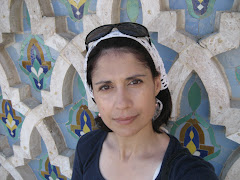Breakfasts healthy or not?


Everyone is a teacher. You just have to listen to them.


Posted by
Alja
at
10:43 AM
14
comments
![]()



Posted by
Alja
at
9:04 AM
0
comments
![]()


Posted by
Alja
at
1:48 PM
2
comments
![]()
HAGIA SOFIA: During our days in istanbul we chose to visit following historical buildings: the famaous museum Hagia Sofia and the Blue Mosque.
During our days in istanbul we chose to visit following historical buildings: the famaous museum Hagia Sofia and the Blue Mosque.

Hagia Sofia (the former mother church of all eastern Christianity, both ortodox and catolic) was constructed already at 530 AD! It was originally a Roman patriarchal church where the eastern Ortodox religion florished and ruled for nearly 1000 years. At that time Istanbul was "the new Rome", called Constantinople. Later the Ottoman Turks concored and turned Istanbul Islamic. Hagia Sofia then became a Mosque. Today it´s a museum filled with historical vibartion and valuable art.
Don´t miss this huge master piece if you are in istanbul!
The entrance fee is 10 Lira (about 5 euro).
THE BLUE MOSQUE:


The Blue Mosque is an impressive landmark for Istanbul with its Dome, semidomes, yards and minarets. The mosque was founded by Sultan Ahmed and was built in the beginning of 1600.
The Muslims still go to the mosque for daily prayers so be prepared for respecting the customs concerning non-muslims when you enter; enter barefoot and have scarves to cover your head, arms and legs as a female (also my son had to cover his arms). Scarves and bags for your shoes are provided at the tourist entrance.
Posted by
Alja
at
12:36 PM
54
comments
![]()

The people are very friendly and helpful and on the whole I felt safe and sound being there no matter where I moved around. I didn´t see the poorest places, though.
The history is amazing having traces from 3000 BC! It was not until the 15th century that Istanbul slowly changed from being a Christian empire (the Roman Constantinople) to slowly becoming Islamic. You can witness all this in the very old and breath taking Mosques and museums!
Posted by
Alja
at
11:10 AM
0
comments
![]()

Posted by
Alja
at
2:35 PM
2
comments
![]()



 Being at the beach listening to the waves and drinking Cappuchino is one of my favourite things to do in Life!
Being at the beach listening to the waves and drinking Cappuchino is one of my favourite things to do in Life!
Varna is a positive surprise to me. It's nice, green, fresh and with many open and friendly people! Coming from Bucharest in Romania I can't help to notice the difference.
Varna has become touristic (with advantage and disadvantage?) with all the beach resorts outside the city (Golden sands, Albena) but it seem like the locals lives in happy co-existance with the tourism, especially in Varna city. The city itself has quite nice beaches and many beach cafees and restaurants. One important thing to discover is the beautiful Sea side park, which is considered to be the biggest in Europe with its 8 km promenade, museums and historical monuments. The sea side park is a popular strolling ground for locals as well as curious visitors in all ages.

Posted by
Alja
at
3:06 AM
7
comments
![]()
